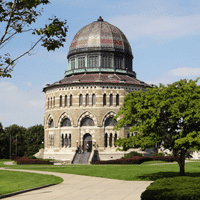Out of 630 universities, ranging from Ivy League institutions to more locally revered liberal-arts colleges, Union College in Schenectady, New York, took first place in the Per Capita Classic and Cardboard divisions in the 2011 RecycleMania Tournament. The competition rates participating college and university recycling programs in North America, and Union is attempting to hold its title; currently, it’s within the top two spots in the same categories again this year.
In addition to Union’s aggressive recycling initiatives, it has employed numerous energy-conservation systems throughout its 130-acre campus for the benefit of the environment, education, and its bottom line. “It’s great that the world is starting to come to grips with the carbon-footprint issue,” says Loren Rucinski, Union’s director of facilities and planning. “Changing the college culture … is a living-learning experience, which in our estimation is part of the educational process.”
Union plans to become carbon neutral by 2060, a goal set in 2007 when president Stephen Ainlay signed the Presidents’ Climate Commitment. “It doesn’t sound very aggressive,” says Fred Puliafico, associate director of utility management. “But the first big milestone is in 2015, where we should be reduced by about 15 percent over what our output was in 2009, and that’s pretty significant.” So far, the school is on target.
In 2010, Union underwent a campus-wide energy audit as part of the Flex Tech Program. The audit was split between two passes. “They went through the buildings and looked for the low-hanging fruit, so to speak—the easier ones to acquire—and then went back and did a few more detailed projects that would take longer,” Puliafico says. The college invested $1.5 million in the suggestions from the Flex Tech Program. Most were less than two-year paybacks, and a majority of the projects were upgrades to high-efficiency lighting with occupancy sensors. Building management controls for the HVAC systems and modifications to the motor systems were included in the audit. Many projects involved improving the building envelope with tighter insulation, better fitting doors, and seals.
The biggest challenge during the audit was accessing the space. Being a trimester school, there is only a short window between sessions, and Union hosts various programs on campus during the summer when the students are gone. “We really have to dance around with the schedule so we can get in there and do the work,” Rucinski says. “We picked the most promising ones at the time, so there are several projects that we pick away at.” The first wave of work was completed at the end of summer of 2011.
Union College employs an array of renewable-energy technologies—not just because it will lower the operating budget or impact energy savings, but because they provide a test bed for students to explore and learn. The school has several solar-photovoltaic and solar-thermal installations on various buildings as well as at its boiler house. “These were not installed just with the idea of saving energy and reducing our carbon footprint, although that was the driving factor,” Puliafico says. “We’re in the wrong part of the country to really make them work well; [on] our average winter day, you might see sun for a couple hours if you’re lucky.” Instead, the solar arrays and other features are living-learning projects to inform students’ decisions and to test new systems. To Rucinski and Puliafico, this is just as important as reducing the college’s carbon footprint.


